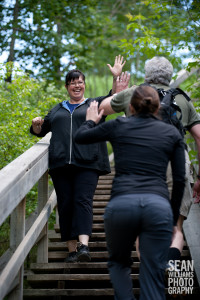As a family doctor, I look after people throughout their life. I often see the impact of lifestyle choices on the health of my patients, both good and bad. An increasing number of my patients have preventable chronic conditions like hypertension, cardiovascular disease and diabetes. Despite evidence showing that lifestyle interventions could substantially reduce costs and complications of these medical conditions,1-4 the application of these results into primary care has been low.5 In a recent national survey in primary care, less than half of family doctors (FDs) reported discussing obesity and physical activity with their patients during their periodic health examinations.5 Reasons for the poor implementation of lifestyle interventions in primary care include lack of time, lack of resources, and limited training.6-9
Several years ago while working in my clinic encouraging my patient to stay active and decrease their stress levels, I noticed a problem. Most of the patients that I am encouraging to be active spend thirty minutes (sometimes less but sometimes more) sitting in a chair waiting for me. What is worse is that, for many, one of the most stressful event of their day is struggling to find parking before they sit and wait for me. Then I ask them to find 30 minutes a few times a week to get the recommended 150 minutes of moderate to vigorous physical activity per week. What if rather than waiting for me, they are just doing their physical activity!
This is where my brain starts to think big, and I have another crazy idea! What if we ran in a clinic in the river valley where people can get some exercise rather than waiting for the doctor? This could be an extension of the house call – the physician leaves the clinic setting to go out to meet patient, but instead of at their home it is in a park. There are many potential advantages to this clinic in the park idea. Patients spend less time sitting. Parking is free and easy. Patients achieve their daily exercise. In addition, there is evidence that time in nature (sounds of a creek or river) are good for your health.10-11 I admit, some things do not work with this idea. No spot for a comprehensive medical exam, and the potential for a medical discussion to be heard by other people. Perhaps there could be another way for me to engage with my patients in the great outdoors to encourage them to exercise.
So, despite the original idea of an Edmonton river valley clinic not working, that idea was the catalyst for development of the “MOVE” program. The powerful influence of a family doctor on patients’ behaviour has been reported previously.12 What if your family doctor not only told you that you need to exercise but actually exercised with you. It makes it more difficult for you to no-show to that workout.
In Edmonton, as part of the Edmonton Oliver Primary Care Network (PCN), Matthew Kallio and I decided to make this possible. Through primary care reform, team based care is becoming more common. This may be in the form of PCNs in Alberta or Family Health Teams in other parts of the country. 13-14 This team based care creates the opportunity for programs like “MOVE” (www.moveyeg.ca).
References:
- Gouveri ET, Tzavara C, Drakopanagiotakis F, Tsaoussoglou M, Marakomichelakis GE, Tountas Y, Diamantopoulos EJ. Mediterranean diet and metabolic syndrome in an urban population: the Athens Study. Nutr Clin Pract. 2011 Oct;26(5):598-606.
- Kastorini CM, Milionis HJ, Esposito K, Giugliano D, Goudevenos JA,Panagiotakos DB. The effect of Mediterranean diet on metabolic syndrome and its components: a meta-analysis of 50 studies and 534,906 individuals. J Am Coll Cardiol. 2011 Mar 15;57(11):1299-313.
- Engström G, Hedblad B, Janzon L. Hypertensive men who exercise regularly have lower rate of cardiovascular mortality. J Hypertens. 1999 Jun;17(6):737-42.
- Rubenfire M, Mollo L, Krishnan S, Finkel S, Weintraub M, Gracik T, Kohn D, Oral EA. The metabolic fitness program: lifestyle modification for the metabolic syndrome using the resources of cardiac rehabilitation. Cardiopulm Rehabil Prev. 2011 Sep- Oct;31(5):282-9.
- Katz A, Lambert-Lanning A, Miller A, Kaminsky B, Enns J. Delivery of preventive care: the national Canadian Family Physician Cancer and Chronic Disease Prevention Survey. Can Fam Physician 2012;58:e62-e69
- Australian Primary Care Research Institute. The Centre for Obesity Management and Prevention Research Excellence in Primary Health Care. Australia: Australian Primary Care Research Institute 2012. Internet: http://aphcri.anu.edu.au/research-program/centres-research-excellence/centre- obesity-management-and-prevention-research-excellence-primary-health
- Lau DC, Douketis JD, Morrison KM, Hramiak IM, Sharma AM, Ur E. 2006 Canadian clinical practice guidelines on the management and prevention of obesity in adults and children [summary]. CMAJ 2007;176:S1-13
- Petrella RJ, Lattanzio CN, Overend TJ. Physical activity counseling and prescription among Canadian primary care physicians. Arch Intern Med. 2007;167(16):1774-81.
- Petrella RJ, Koval JJ, Cunningham DA, Paterson DH. Can primary care doctors prescribe exercise to improve fitness? The Step Test Exercise Prescription (STEP) project. Am J Prev Med. 2003;24(4):316-22
- Lee AC, Maheswaran R. The health benefits of urban green spaces: a review of the evidence. J Public Health (Oxf). 2011 Jun;33(2):212-22.
- Mowen A, Orsega-Smith E, Payne L, Ainsworth B, Godbey G. The role of park proximity and social support in shaping park visitation, physical activity, and perceived health among older adults. J Phys Act Health. 2007 Apr;4(2):167-79.
- D Klein, K Crawford, M Singal, C Pittman. A crazy little idea. Canadian Family Physician 59 (6), 704-704.
- Alberta Government. PCN in Alberta. [Place Unknown] 2014. Cited August 25, 2014. Available from http://www.albertapci.ca/AboutPCNs/PCNsInAlberta/Pages/default.aspx
- Ontario Government. Family Health Teams. [Place Unknown] 2014. Cited August 25, 2014. http://www.health.gov.on.ca/en/pro/programs/fht/

